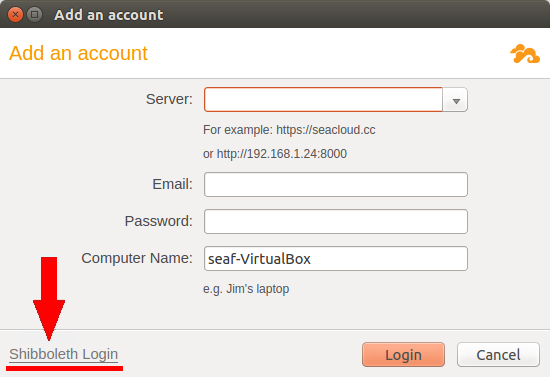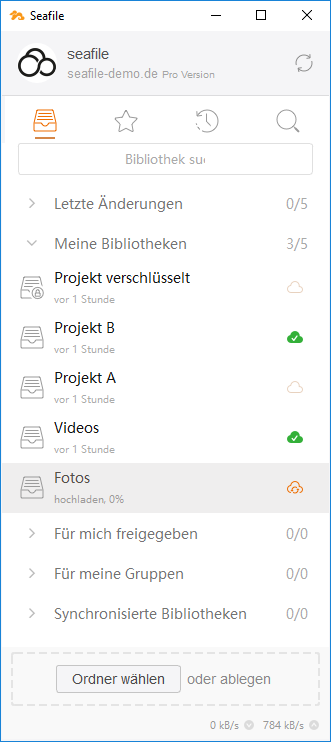

- SEAFILE CLIENT API NO CREDENTIALS ANDROID
- SEAFILE CLIENT API NO CREDENTIALS CODE
- SEAFILE CLIENT API NO CREDENTIALS PASSWORD
SEAFILE CLIENT API NO CREDENTIALS PASSWORD
In my environment for example I have 16 apps that all use oidc so if a user changes their password its changed in all apps, also once you are logged in all the websites just work for awhile. You don't want to do local accounts though, when you have active directory with a few users you don't want to manage the credentials in every app. If an app doesn't support oidc you can use something like oauth2-proxy to wrap the website in a way to gather credentials. The app uses these to know the username, and can use the groups for permissions, such as an admin group, to grant admin privileges. The login comes along with "claims", such as "username" and a list of "groups" the user is a member of. then, after the app comes up instead of logging in with a username and password there will be a button to do the oidc login, it redirects to keycloak for credentials as it can see no one is logged in, you log in via the identity provider, it redirects back to the app and you are logged in. In that yaml file you specify the container image to use, in this case joplin-server, and some configuration such as the oidc configuration to use in my case keycloak (the upstream redhat sso solution), or azure, or any identity provider really as they all support oidc. In a modern kubernetes setup, kubernetes being a container management system, along with a gitops setup (using either argocd or flux), you confgure the appliction deployment using a yaml file. and have ended up here, this post is 6 months old so i'm hoping it has already been integratedĮverything web-related is pretty much expected to have oidc support. Oidc is incredibly prevalent out in the world at this time in history, as i look into joplin to see if i might onboard it into my environment, as with all web apps i first check if it is oidc compatible.
SEAFILE CLIENT API NO CREDENTIALS ANDROID
I use Seafile, which doesn't support SSO for WebDAV there's no Android client that actively syncs filesystem to Seafile with SSO credentials, so I can't use filesystem sync and Joplin Server doesn't yet support SSO.) (As an aside, this came about bc I couldn't find an acceptable way to sync Joplin notes with the sync targets when using SSO.
SEAFILE CLIENT API NO CREDENTIALS CODE
Just tinkering, I've got OIDC login working, but don't want to code up the app password hashing/storage/UI/&c. SSO users would then use the app passwords for authentication in the Joplin clients. Would maintainers be open to a PR adding OpenID Connect support to Joplin Server? The idea would be to have a "Or log in with single sign-on" link on the login page, then an "App Passwords" section of the user form/profile page. I want to self-host Joplin Server for my own use, but I use single sign-on for all my self-hosted apps. I guess this is kind of a feature question as well, I suppose. I don’t see at all what I did wrong or I don’t find any clue about what can be the problem.(I posted this to Features, but I think it might've gotten buried.) I even tried to reboot server without any imrpovement. The second one didn’t help either, I tried to restart seafile, but also to empty cache and it didn’t work. questions/26906630/django-rest-framework-authentication-credentials-were-not-providedīut they doesn’t help: the first one has 2 solution: one that concerns wsgi that I haven’t and another one that concern django framework that I don’t know at all that’s why I can’t apply it. I followed again documentation for the configuration and it seems that I have exactly the same config (following deploying with mysql, then seahub with apache, then https on apache).įound some django post that speak about this problem: I tried to force certbot to create a certificate for seafile but it doesn’t seem to chnge anything. Which means that they’re seen and linked to the account.Ītm letsencrypt used a single certificate for all my subdomain but the folder where the cert is, is named with another subdomain. When I try to connect a client to my account, on my seafile web page on my linked devices I can see my computers.

SetEnvIf Authorization "(.*)" HTTP_ATHORIZATION=$1įor me there is a problem with apache or let’s encrypt, else I would have server side errors…

No error message server side but client side yes, I have: Using web interface, I can go on my server without any problem, but with the client I can’t connect to the server with a french “Connection Impossible” I work with seafile behind apache with HTTPS on ubuntu 14.04 using let’s encrypt. Just reinstalling my seafile server because I did some mistake that make the client unable to work properly.


 0 kommentar(er)
0 kommentar(er)
